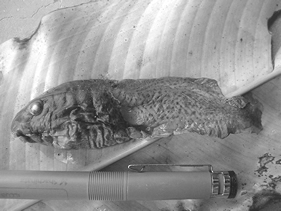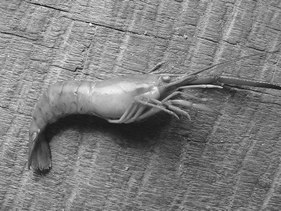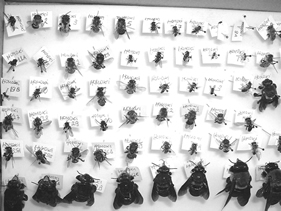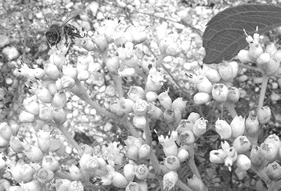Fauna
Hunting
A list of game animals hunted by the Yanomami at Homoxi is given in Appendix 10, together with information on their current status and whether or not they were hunted by the gold miners. For a more in-depth discussion of the effect of the garimpeiros in game see Impact on game resources.
Fishing and
related activities
Fishing provides a supplementary (but nonetheless dependable and regular) source of protein for the Yanomami, particularly during the dry season. There are no large fish in the Homoxi region, but small fish (up to about 15cm) are taken from the streams and (now) from the man-made lagoons, either with hooks and lines (when the waters are high) or with vegetable fish poisons (when the waters are low). This is an activity primarily undertaken by women. The main fish species eaten are as follows:
Table 1: Fish caught at Homoxi
|
Yanomami name |
Species |
Mode of capture |
|
etahi pė |
Callichthys callichthys |
poison |
|
komarima pė |
Lebiasina sp. nov. [1] |
hook |
|
raasirima pė |
Astyanax aff. mucronatus |
hook |
|
tihikuru uxi pė |
Ancistrus sp. |
collect from rocks |
|
yõra pė |
[acari]* |
poison |
|
watatarima pė |
? |
poison |
|
maku utumo pė |
? |
poison |
* Brazilian name
It was said that the fishes in some of the man-made lagoons are found to have unusually loose flesh, possibly as a consequence of water quality (e.g. pollution). These are eaten but not relished as much as firmer-fleshed fish. In the lagoons with the poorest water (red) it was said that fish have been caught with unusual warty protuberances on their skin and with deformed mouths. These fish are not eaten.
The women have an extremely detailed knowledge of fishing locations along the courses of all the streams in the region (see Fig. 68), and also of suitable locations for collecting crabs and prawns. Crabs and prawns in the areas worked by gold miners were said to have a blacker appearance than they did before the miners came. The main species of prawn collected at Homoxi is Macrobrachium brasiliense - a species with a wide distribution in Amazonia. The only crab specimen taken at Homoxi was not sufficiently mature to be identified with certainty, but collections made by Victor Py Daniel at Xitei and Parafuri (and lodged in the invertebrate collection at INPA) include the following species:
Fredius platyacanthus Rodriguez &
Pereira
Fredius stenolobus Rodriguez &
Suarez
Fredius estevisi
estevisi Rodriguez & Pereira
Other aquatic species collected for food include a riverine mollusc called xitokoma akasi (Aylocostoma sp.).[2]
|
|
|
Amphibians and
reptiles
The Yanomami of Homoxi eat a number of
frogs including hraehraemapė, koanapė, prikima asipė (small and pale), pikimoripė
(large and dark), harixu unapė (large and striped), pariki riapraremapė
(small and dark) and mokapė. They also collect two types of tadpoles: xaa xipė (immature stage of harixu unapė) and tookoroxipė (immature stage of pikimoripė). A specimen of xaa xipė, which is found in natural lakes and man-made lagoons, was
examined by Dr Albertina Lima of INPA and tentatively identified as a species
of Pseudis. However, it is not the tadpole of the only known member of this
genus (P. paradoxus), and may
represent a new species.
Edible toads include kroumapė, hatupopė and yoyopė (Bufo marinus). There is also an edible lizard called rema aka.
Bees
At the time of study the large areas of open ground (gravels and secondary vegetation) in the Homoxi region supported numerous flowering shrubs and herbs attracting a large variety of bee species including native species (principally Meliponini and Trigonini) and European/African hybrids (Apis mellifera). White flowered species (e.g. Clibadium cf sylvestre and Uncaria tomentosa) and pale green flowered species (e.g. Gramineae) were notably attractive to these bees.
|
|
|
During the mornings the abundant grasses, for example, were visited by large numbers of Apis mellifera and Trigonini. The Meliponini were more commonly found on white or yellow flowers, particularly those with elongated stamens such as the common Desmodium spp. These were visited throughout the day, even in the short intervals between falls of rain. Exotic or escaped species such as Bixa orellana (anatto) and Psidium guajava (guava) also attracted notable numbers of Meliponini and Trigonini.
Although it is commonly accepted that Amazonian bees tend not to visit red, blue or purple flowers, Apis and certain Trigonini regularly visited such flowers at Homoxi, in particular those of Emilia sonchifolia. Apis collected voraciously from this species even when there was an abundance of other white, yellow or green flowers in the area.
A list of the bees collected at Homoxi is given in Appendix 9, together with their common names. Approximately 40 species were collected,[3] corresponding to 31 Yanomami names.[4] These probably include all of the common species in the area but there are undoubtedly several more species present. Two nests were found: one in the trunk of the large Eucalyptus tree close to the Post and one in the ground beside a tree stump beside the Tirei maloca.
There was considerable difference in the names used for bees by the Yanomami of Homoxi and of those of the lowlands (e.g. Demini). Apis mellifera is known in the Demini and Catrimani regions as remoremo moxi, for example, whereas at Homoxi it is known as teusina.[5] Also, whereas at Demini four types of Meliponini are attributed the same name (maxopoma), at Homoxi each of these has a separate name (of which one is maxopoma).
Options
for honey production
The regenerating vegetation in the areas damaged by gold mining at Homoxi provides large amounts of nectar for a wide range of honey-producing bee species. Most of these bees probably nest in the surrounding forest, which, by virtue of the relatively small clearing size, is never far away. Wild honey does form a traditional part of the Yanomami diet, and that of certain species is attributed with medicinal properties. However, there was no evidence of honey collection or consumption during the current visit, possibly reflecting the general dependence on external food sources that developed during while the garimpeiros occupied the region. Apiculture (using native species) could play a useful role not only in helping the Yanomami communities to overcome the residual effects of this dependence, but also by providing a potential source of income for these communities.[6] The price of honey in northern Brazil is one of the highest in the country, with Apis honey costing R$10.00 per Kilo and Melipona honey costing R$50.00.
Other insects
The most important edible insects are caterpillars,
which occur in swarms on certain species of trees at certain times of the
year. These can be extremely abundant,
whole basket-loads being collected and roasted in the fire wrapped in leaves. Species eaten in the Homoxi region include kaxapė (which feeds on trees such as krepu uhi, toxa hi, rixira hi, poata hi and rarima hi),[7]
raemasiki, momonama kiki, mayakiki and wakanariaki. In addition to the caterpillars, certain
species of termites (including arepapė
and haamapė) and ants (including oxepė) are eaten.
Medicinal fauna
A few animal species are traditionally used for medicinal purposes in the Homoxi region (see Table 10), although these are no longer commonly used. These include the following:
Table 2: Some animal species used for medicinal purposes in the Homoxi region
|
Yanomami name |
Animal type |
Use |
|
xitokoma akasi |
Riverine
mollusc |
Fevers |
|
waremopė |
Red ant |
Fever &
other symptoms attributed to sorcery |
|
mayoramapė |
Red ant |
Leg pains
associated with sorcery |
|
xaa xi |
Tadpole (Pseudis sp.?) |
Fever in
children |
|
maipė |
Insect eggs[8] |
Leg pains
associated with sorcery |



